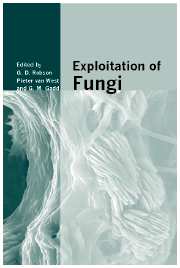Book contents
- Frontmatter
- Contents
- List of contributors
- Preface
- I Comparative and functional fungal genomics
- II Bioactive molecules
- III Protein folding and secretion
- IV Fungal bioremediation
- 10 Metal stress and the single yeast cell: Berkeley Award Lecture
- 11 Bioluminescence-based fungal biosensors
- 12 White-rot fungi and xenobiotics
- 13 Metal and mineral transformations: a mycoremediation perspective
- V Fungal biocontrol of pests
- Index
- References
10 - Metal stress and the single yeast cell: Berkeley Award Lecture
from IV - Fungal bioremediation
Published online by Cambridge University Press: 05 October 2013
- Frontmatter
- Contents
- List of contributors
- Preface
- I Comparative and functional fungal genomics
- II Bioactive molecules
- III Protein folding and secretion
- IV Fungal bioremediation
- 10 Metal stress and the single yeast cell: Berkeley Award Lecture
- 11 Bioluminescence-based fungal biosensors
- 12 White-rot fungi and xenobiotics
- 13 Metal and mineral transformations: a mycoremediation perspective
- V Fungal biocontrol of pests
- Index
- References
Summary
Introduction
Overview
This paper explores the mechanisms of metal toxicity towards cells, specifically some advances being made in this area through work with the unicellular fungus, Saccharomyces cerevisiae. The two principal questions addressed here are:
Is oxidative damage the cause of cellular metal toxicity?
Why do individual cells exhibit widely differing metal resistances?
Several powerful experimental tools are unique to S. cerevisiae among eukaryotes, and are being exploited to help elucidate the mechanism(s) of metal toxicity. Furthermore, in conjunction with its unicellular morphology, S. cerevisiae provides an ideal system with which to explore the topical problem of cell individuality, applied here to metal toxicity. This chapter provides an overview of these fields, illustrated with key findings from the author's laboratory.
Metals in the environment and relevance to fungi
A wide range of industrial activities give rise to metal pollutants, which continue to be released into the environment at potentially harmful levels. Localized concentration of certain metals may also arise naturally. For example, toxic levels of the biologically essential metal copper are often associated with certain mineral ores as well as industrial or agricultural discharges. Cadmium is used widely in electroplating and galvanizing industries, as a colour pigment in paints and in batteries, and as a by-product of zinc and lead mining and smelting. Zinc, lead and other metals also may be released from similar types of sources.
- Type
- Chapter
- Information
- Exploitation of Fungi , pp. 161 - 186Publisher: Cambridge University PressPrint publication year: 2007



